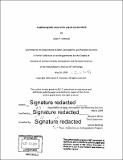| dc.contributor.advisor | Benjamin Weiss. | en_US |
| dc.contributor.author | Slotznick, Sarah Pearl | en_US |
| dc.contributor.other | Massachusetts Institute of Technology. Department of Earth, Atmospheric, and Planetary Sciences. | en_US |
| dc.date.accessioned | 2018-03-27T14:19:50Z | |
| dc.date.available | 2018-03-27T14:19:50Z | |
| dc.date.copyright | 2009 | en_US |
| dc.date.issued | 2009 | en_US |
| dc.identifier.uri | http://hdl.handle.net/1721.1/114376 | |
| dc.description | Thesis: S.B., Massachusetts Institute of Technology, Department of Earth, Atmospheric, and Planetary Sciences, 2009. | en_US |
| dc.description | Cataloged from PDF version of thesis. | en_US |
| dc.description | Includes bibliographical references (pages 25-30). | en_US |
| dc.description.abstract | Sahara 99555 (SAH 99555) is the oldest dated angrite sample, a rare type of meteorite, and is only ~2 Myr younger than the age of the solar system (1, 2). SAH 99555 shows no post-cooling brecciation or weathering from the parent body, and does not display signs of significant terrestrial weathering. Therefore, paleomagnetic experiments were conducted for the first time on SAH 99555 to discover if it contains a primary paleomagnetism and then to determine a paleointensity estimate and its ferromagnetic mineralogy. Our studies show that the primary ferromagnetic mineral in SAH 99555 is magnetite and there are also some accessory ferromagnetic minerals including titanomagnetite and hematite. The natural remanent magnetization (NRM) of SAH 99555 appears to have a low-coercivity component probably from a collector's hand magnet or the Earth's field as well as a high-coercivity component, similar to D'Orbigny, another angrite. The paleointensity measurements of the high-coercivity component of SAH 99555,5 agree with the paleointensity estimates made for other angrites (D'Orbigny and A-881371) by Weiss et al. (2008) (4). Therefore, it appears that SAH 99555 does record a primary paleofield from when it was on the angrite parent body, which would be the oldest known paleomagnetic record yet identified in a planetary rock. Further studies are suggested to verify these conclusions, which make SAH 99555 one more key data point in the understanding of the early solar system. | en_US |
| dc.description.statementofresponsibility | by Sarah P. Slotznick. | en_US |
| dc.format.extent | 57 pages | en_US |
| dc.language.iso | eng | en_US |
| dc.publisher | Massachusetts Institute of Technology | en_US |
| dc.rights | MIT theses are protected by copyright. They may be viewed, downloaded, or printed from this source but further reproduction or distribution in any format is prohibited without written permission. | en_US |
| dc.rights.uri | http://dspace.mit.edu/handle/1721.1/7582 | en_US |
| dc.subject | Earth, Atmospheric, and Planetary Sciences. | en_US |
| dc.title | A paleomagnetic study of the angrite Sahara 99555 | en_US |
| dc.type | Thesis | en_US |
| dc.description.degree | S.B. | en_US |
| dc.contributor.department | Massachusetts Institute of Technology. Department of Earth, Atmospheric, and Planetary Sciences | |
| dc.identifier.oclc | 1028993552 | en_US |
